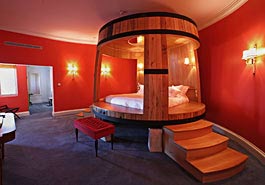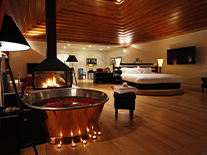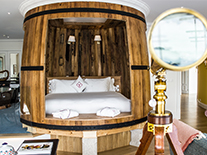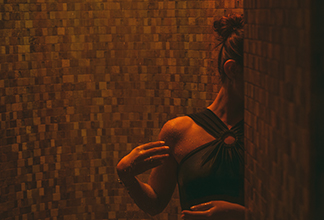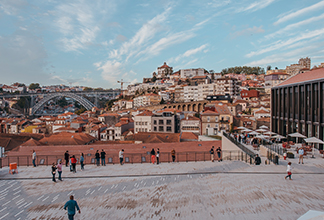1. The Party!
The party is a celebration for Porto’s patron saint, São João. Many Portuguese towns celebrate their saints with fireworks and street parties, stalls and fun and games with each town benefiting from a local bank holiday on the saint’s day. The official party of São João starts on the evening of the 23rd June. Appreciated by tourists and much the pride of local Porto residents, more than 200,000 people take part in the revelry, culminating in a spectacular firework display over the River Douro lasting about 15 minutes, usually around midnight. St John‘s festival is much loved by Portuguese people of all ages and is very much a family event. Traditions range from launching hot air balloons into the sky and hitting plastic hammers on the heads of passers-by, to waving garlic in people’s faces, jumping bonfires and offering friends and relatives potted basil plants decorated with traditional poems. It’s a time to get together with friends and family; or take a walk through the streets towards the spectacle of the best firework display in town. The main attraction is the fun it provides as well as the local holiday. It’s a day to put one’s troubles aside and enjoy some fun and laughter. The streets are full of stalls and decorations, music can be heard everywhere and popular songs are sung. Since the weather is usually very hot this time of year, the traditional fare is delicious grilled sardines, green peppers and rice and traditional Portuguese cabbage soup, called Caldo Verde. The smell of grilled sardines fills the city as it radiates from street corners and gardens to restaurants and beaches. The evening promenade is de rigueur from Porto’s old riverside area to Foz. For the strong hearted, the party will go on until sunrise with many parties taking place on the beach. Those who don’t want to brave the crowds usually have a party at home.
2. How did it all start?
The origins of all this partying however go back many years when the celebratory rituals were different to those of the present day. The history of St. John’s festival originated in the XIVth century, when it was initially a pagan festival held in honour of the sun god and in commemoration of harvests and abundance. It was only later, the Catholic Church christianized the party in commemoration of St. John, the patron saint.
3. Why the herbs?
In bygone days, part of the pagan ritual was to aid fertility. At the time, leeks were hung on front doors of houses and were considered to bring luck to the families living there. They would be replaced the following year. On the night of the 23rd June, groups of families would leave their neighbourhoods on foot to the old riverside part of Porto to see the traditional St John’s painted ‘models’ and typical scenes, and to buy leeks from the farmers along the way and other symbolic vegetables such as vases of basil and bunches of lemongrass and carnations.
Herbs played an important role in the celebration too, for their power to bring health, luck and fortune, when in Roman and Celtic times, they were used in antique rituals for their magical and therapeutic properties. During the São João period, people buy small pots of basil to decorate the home.
4. Fireworks!
Other popular traditions were the St John bonfires. These were lit in Porto’s streets and revellers would dare each other to jump the flames to prove their courage as well as their belief in the purifying virtues of fire to bring good health, happiness and a healthy marriage. Families, even in those days, would flock to the streets in crowds, taking joyful strolls through various points of the city towards the old riverside area of Porto, where they would take part in friendly street fights. Today, these traditions have been transformed into a spectacular fireworks display which lights up the sky over the Ponte Dom Luís and the Douro river, as thousands of visitors fill the streets below.
5. Plastic hammers
Over time, some of the rituals changed and new elements were introduced, making the party more complete and what it is today. One of the important props today from the St John festival, is the plastic hammer. The St. John’s hammer was invented in the 20th century by the owner of a plastics factory in Porto, who took the idea from a plastic salt and pepper pot he saw on a trip abroad. His first objective was to add a new toy to his portfolio. However, after it was successfully sold in the university students’ graduation parties in Porto, the hammer took off as one of the number one props and they have been used ever since for the St John’s festival, making it now one of the great attractions of the day.
The party is a celebration for Porto’s patron saint, São João. Many Portuguese towns celebrate their saints with fireworks and street parties, stalls and fun and games with each town benefiting from a local bank holiday on the saint’s day.
The official party of São João starts on the evening of the 23rd June. Appreciated by tourists and much the pride of local Porto residents, more than 200,000 people take part in the revelry, culminating in a spectacular firework display over the River Douro lasting about 15 minutes, usually around midnight.
St John‘s festival is much loved by Portuguese people of all ages and is very much a family event. Traditions range from launching hot air balloons into the sky and hitting plastic hammers on the heads of passers-by, to waving garlic in people’s faces, jumping bonfires and offering friends and relatives potted basil plants decorated with traditional poems. It’s a time to get together with friends and family; or take a walk through the streets towards the spectacle of the best firework display in town.
The main attraction is the fun it provides as well as the local holiday. It’s a day to put one’s troubles aside and enjoy some fun and laughter. The streets are full of stalls and decorations, music can be heard everywhere and popular songs are sung. Since the weather is usually very hot this time of year, the traditional fare is delicious grilled sardines, green peppers and rice and traditional Portuguese cabbage soup, called Caldo Verde. The smell of grilled sardines fills the city as it radiates from street corners and gardens to restaurants and beaches.
The evening promenade is de rigueur from Porto’s old riverside area to Foz. For the strong hearted, the party will go on until sunrise with many parties taking place on the beach. Those who don’t want to brave the crowds usually have a party at home.
2. How did it all start?
The origins of all this partying however go back many years when the celebratory rituals were different to those of the present day. The history of St. John’s festival originated in the XIVth century, when it was initially a pagan festival held in honour of the sun god and in commemoration of harvests and abundance. It was only later, the Catholic Church christianized the party in commemoration of St. John, the patron saint.
3. Why the herbs?
In bygone days, part of the pagan ritual was to aid fertility. At the time, leeks were hung on front doors of houses and were considered to bring luck to the families living there. They would be replaced the following year. On the night of the 23rd June, groups of families would leave their neighbourhoods on foot to the old riverside part of Porto to see the traditional St John’s painted ‘models’ and typical scenes, and to buy leeks from the farmers along the way and other symbolic vegetables such as vases of basil and bunches of lemongrass and carnations.
Herbs played an important role in the celebration too, for their power to bring health, luck and fortune, when in Roman and Celtic times, they were used in antique rituals for their magical and therapeutic properties.
During the São João period, people buy small pots of basil to decorate the home.
4. Fireworks!
Other popular traditions were the St John bonfires. These were lit in Porto’s streets and revellers would dare each other to jump the flames to prove their courage as well as their belief in the purifying virtues of fire to bring good health, happiness and a healthy marriage. Families, even in those days, would flock to the streets in crowds, taking joyful strolls through various points of the city towards the old riverside area of Porto, where they would take part in friendly street fights.
Today, these traditions have been transformed into a spectacular fireworks display which lights up the sky over the Ponte Dom Luís and the Douro river, as thousands of visitors fill the streets below.
5. Plastic hammers
Over time, some of the rituals changed and new elements were introduced, making the party more complete and what it is today. One of the important props today from the St John festival, is the plastic hammer.
The St. John’s hammer was invented in the 20th century by the owner of a plastics factory in Porto, who took the idea from a plastic salt and pepper pot he saw on a trip abroad. His first objective was to add a new toy to his portfolio. However, after it was successfully sold in the university students’ graduation parties in Porto, the hammer took off as one of the number one props and they have been used ever since for the St John’s festival, making it now one of the great attractions of the day.
BOOKING INFORMATION:
- Email: reservations@theyeatman.com
- Tel: (+ 351) 220 133 128/126/185/137*
CHECK AVAILABILITY





